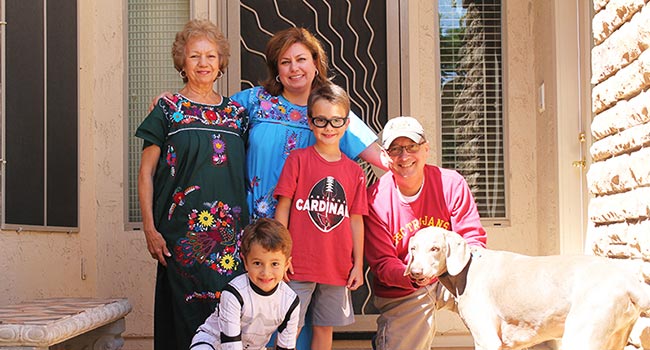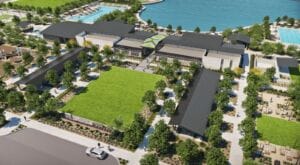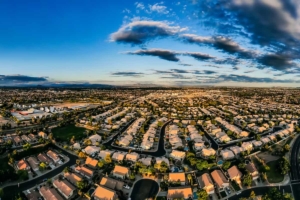Paula West, “over 65,” loves living in a mid-rise, downtown Phoenix condo, surrounded by a diverse group of people.
Juanita Gonzales, 73, prefers living with her family in a large, suburban Litchfield Park home, where she passes down her Mexican culture to her daughter, son-in-law and grandchildren.
Judy and Mel Kauffman, both in their early 70s, moved from Pennsylvania to an active adult golf community in Peoria, where they enjoy a robust social life.
The Phoenix-Mesa-Scottsdale metro area has the highest rate of those 55 and older moving to the area in the nation, according to a study by the National Association of Home Builders, and 38.4 percent of all households in Maricopa County are owned or rented by those aged 55 or older. Baby boomers are redefining retirement living, just as they have affected every stage of life, and developers are taking this into account, turning the Valley into a study in diverse styles of living.
Urban living: Paula West
One of the biggest changes in the Phoenix area has been the increase in seniors purchasing mid-rise condominiums and renting apartments downtown.
West, director of the City of Phoenix Community & Economic Development International Relations Division, recently bought a condo in the mid-rise Portland on the Park in downtown Phoenix.
While sipping a glass of red wine in her sleek, contemporary kitchen, the youthful looking and smartly dressed divorcée explained how she came to live the urban lifestyle.
She lived in a two-story townhouse near her two adult children in Gilbert for 19 years after her divorce. But she broke a few bones and realized that having a staircase was going to make things difficult for her if something serious happened.
“I didn’t want to ask my kids to take care of me,” she said.
She sold her townhouse and rented a midtown Phoenix apartment for a year and a half while she looked for a place to purchase.
“My family was saying, ‘Mom, you should look at an active adult community!’” she said.
Although there was one active adult community she had seen and liked, West ultimately decided she wanted “a little more diversity.”
Eventually she found the newly constructed Portland on the Park, a condominium complex that bills itself as “blurring the distinction between home, work and the neighborhood coffee shop,” according to its website.
“I am so thrilled with this,” she said. “You’ve got Hance Park, lots of restaurants, light rail, one of the best hospitals around is right down the street, and if at some point they take my car keys away from me, I can still get around.”
Her cozy, 891-square-foot eighth-floor condo has sweeping north-facing views and looks over the Japanese Friendship Garden, a sentimental note for her, as one of the first things she did when she went to work for the City of Phoenix was to lay a rock in the garden when the ground was broken for it.
The small size of her new home is in line with research showing that the 55 and up demographic is evenly divided on wanting more space or choosing to downsize.
West also saw the purchase of the condo as practical, looking toward the future.
“I wanted to buy something that would work for my kids in resale – or they can keep it,” she said.
Elevators mean West doesn’t have to take the stairs, and the building is full of amenities like a swimming pool, workout center, rooftop barbecues and a concierge.
“This neighborhood is so wonderful,” she said. “There’s a vibrancy – wonderful things are happening here.”
Urban living attracts boomers
According to Deborah Blake, an expert on retirement housing, millennials (who are in their 20s and 30s) and boomers are “acting more like each other” but for different reasons.
“Millennials are about their quality of life right now because they don’t see a great retirement for themselves in the future, and the boomers are about quality of life right now because they’re actually in that great retirement,” she said.
“They’re in the same cultural venues, the same restaurants as each other, so downtown living is desirable to both of them,” Blake continued.
“If the apartment industry relied strictly on millennials, these downtown apartments wouldn’t be built,” said Tom Simplot of the Arizona Multihousing Association.
Multigenerational homes: Juanita Gonzales
Gonzales lives in a casita attached to the home her daughter, son-in-law, two grandsons and two dogs reside in in Litchfield Park. She lived in the Los Angeles area for many years, before she and her husband moved to Arizona to be near their only child, Mónica Villalobos, eight years ago.
Gonzales’ husband died of cancer a few months after they moved into their new home, so she sold the large, 4-bedroom house and moved into a smaller home down the road from her daughter. When Villalobos and her family decided to move to Litchfield Park, she and her mother made the decision to sell both homes and move in together in the new house.
“I didn’t want to be left alone and I slept at their house all the time anyhow,” said Gonzales.
Living in the same home as her daughter and her family gives Gonzales peace of mind.
“I get a little tired once in a while, or sick, and having a little help here is good,” she said.
Villalobos loves having her mother in the same house, and said she believes that living together is what “keeps my mother going.”
“It’s a natural fit for us,” said Villalobos. “My family came from Mexico, and the importance of family means something to us.”
“My being here adds to making sure my grandkids get their Mexican culture,” said Gonzales. “I have books and games in Spanish and we decorate and make tamales for the holidays,” she said.
“The kids adore their grandmother,” said Villalobos. “And she keeps them in line better than I can!”
The Gonzales/Villalobos family is not unique.
Multigenerational families are common among immigrant households in the U.S., in particular Asian and Hispanic homes.
“In the next 10 to 15 years, there will be huge growth in retirement age Hispanics in Maricopa County,” said Alex Juarez of AARP Arizona, “and typically, Hispanics stay with their family.”
Juarez said he doesn’t see many retirement communities with Hispanic retirees.
“By staying at home around the people they love, it keeps the caregiving cost down,” he said.
Some of the country’s major homebuilders are reacting to the multigenerational trend by developing housing specifically for these households, and developments have popped up across Maricopa County.
Suburban golf community: Judy and Mel Kauffman
The Kauffmans live in a 1,800 square-foot home in Trilogy at Vistancia, a master-planned active adult community in Peoria.
Originally from Pennsylvania, the retired couple moved to Trilogy in 2008.
“To me, living here is like a permanent vacation,” said Judy. “You have the pool, the spa, games, the freedom to go to a museum, ballgames – I never went to summer camp and it’s like camp to me!”
More than 50 resort living communities are listed in the Phoenix area, according to the website 55places.com. They can feature pools, fitness centers, restaurants, spas and sports facilities.
“I realized that not knowing anyone because we’d moved from the East Coast, it would be the best move for us because everyone seemed to be transplanted from somewhere else,” said Judy.
The couple said they love that it’s very easy to make friends and that the community is open and accepting.
“You don’t have a history with any of these people – there are ex-CEOs, doctors, salesmen, but you would never know because everyone seems equal here,” said Mel.
“Ninety people showed up for Mel’s 70th birthday party,” said Judy. “My friends back East were like, ‘How can you possibly know all these people?’”
However, Judy is worried about the future because Trilogy is 45 minutes from downtown Phoenix, and the area is still partly rural.
“This is the farthest I’ve ever lived from something,” she said. “If I want to do something I have to drive to Phoenix or Scottsdale, and the odds are that I wouldn’t be able to live here if I couldn’t get around.”
Active adult communities continue to flourish
“A New, Active Way-of-Life” for “America’s Senior Citizens.” In 1960, those words were used to promote Sun City, one of the very first active adult communities in the United States.
Located just 12 miles from downtown Phoenix, Sun City became the epitome of retirement living, with amenities like shuffleboard, horseshoes and croquet courts for the enjoyment of older citizens.
Traditionally, communities like Sun City catered to wealthy, mostly white, seniors. But today there’s a larger mix of residents, and developments continue to spring up in suburban cities that surround the downtown Phoenix area.
“The active adult buyer is a blue-collar, pink-collar civil servant who still has a pension – who takes their equity and puts it into a new home,” said Blake.
“There are also retired executives who are wealthy but don’t care about keeping up with the Joneses – what they’re interested in is community,” she said.
But, said Blake, the motivations for living in an active adult community remain the same as they ever did.
“The old Sun City movie they made is as relevant today as it was then with the guy retiring and getting the gold watch, then he’s bored and needs something to do,” she said.
Low-income apartments: Ruth Wiesehan
But what if retirees cannot afford to live in a condo, active adult community or multigenerational home?
Ruth Wiesehan, a 65-year-old retiree, has lived at the City-managed Pine Tower apartment complex in central Phoenix for six years.
The outspoken widow lived with a daughter and son-in-law for two years before she found out about Pine Tower.
“I came and looked at it and I was really impressed,” Wiesehan said.
“We offer many of the same things that a higher end residence does,” said William Emerson, deputy housing director for the City of Phoenix.
The city directly manages five independent living properties with studio and one-bedroom units. Rent is 30 percent of the resident’s adjusted monthly income, and all utilities except cable and telephone are included in the rent.
Demand is high, and Emerson said all five complexes are popular.
“We have a wait list of 27,000 people,” he said. “It can take as short as six months or longer than two years.”
Wiesehan likes that there are lots of amenities nearby because she no longer drives, and that the building also provides transportation to the grocery store every week at no additional cost.
Adjusting to senior apartment living was difficult for her at first because she had never lived in multiunit housing before.
“I was always a more private person, and personalities were different,” she said.
But she got used to it and eventually applied to be the resident assistant on-site, where she’s the eyes and ears for the building manager.
“My nursing background comes in handy,” Wiesehan said, “and I felt I could do a good job because I had the skill to say ‘no’ if needed.”
Pine Tower provides residents with activities from crafts and movies to health care screenings.
Wiesehan is happy she made the move, even though her daughter moved back east and is no longer nearby.
“I am pretty self-sufficient,” she said, “and I talk to my kids and 12 grandchildren by phone at least once a week.”
“I love the kids, but I like quiet as well – I love them but I like my time away,” she added.
The future
Senior housing developers in Arizona will need to keep diversity in mind as the years go by, according to Blake.
She said that up until now, the results of research for active adult community living has shown that most of the residents and prospective residents are white, married and wealthy.
“But there’s this whole other part of the population that is not understood by the market,” she said, “and the majority of those 55 and up are going to live in places other than active adult communities.”
Blake predicts that more and more seniors will choose to live in “porous” communities that are not gated and have more connections to other developments in the same area that are not age-restricted.
She said multigenerational housing will continue to grow in Phoenix, not just because of the Hispanic population, but also due to adult children not moving out of the house or moving back in after time away.
She also thinks the downtown boom will endure, with seniors driving the re-urbanization efforts, and Generation X and millennials lending a hand.
“In the end, lifestyle trumps everything,” said Blake. “Older adults know what they want and they are that critical mass that affects all of us in development.”
By Mindy Reinsenberg, Cronkite News




